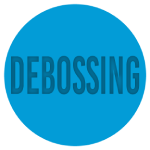Table of Contents
Introduction
In the realm of product differentiation, the selection of an optimal printing technique for notebooks presents a critical juncture. This decision profoundly impacts not only the visual aesthetics of the final product but also its production cost and, consequently, its market positioning. This blog delves into the technical nuances of seven popular printing methods employed in adorning notebooks, meticulously dissecting their functionalities, applications, and inherent advantages and limitations to help readers make informed decisions.
7 Popular Methods Used for Printing Notebooks

Debossing
How does Debossing work?
Debossing, or blind embossing, is an intricate technique involving relieving images into materials. The debossed appearance is attained by applying pressure and heat to a brass piece milled with a design using a die-stamp.
Used for
- Business Cards
- Logo Printing
- Book Covers
Benefits
- It creates a subtle, elegant look, ideal for a sophisticated finish
- Adds depth and dimension to the design
- Makes the design durable and scratch-resistant
Downsides
- Requires specialized equipment and dyes, making it more expensive
- It may not be suitable for very intricate designs due to dye-limitations
- Debossed features might be less noticeable on thick/textured materials

Offset Printing
How does Debossing work?
Offset printing transforms digital designs into metal plates that attract ink in the image area. The designs are then transferred to a rubber blanket cylinder pressed onto paper.
Used for
- Magazines
- Brochures
- Notebooks
Benefits
- Versatile and cost-effective for bulk printing
- Creates high-quality image reproductions and sharp texts
- Ensures consistent color reproductions during a print run
Downsides
- Setting up offset-printing is expensive and time-consuming
- Not suitable for small-printing purposes and variable-data printing
- Utilises inks and solvents which are neither biodegradable nor eco-friendly

Digital Printing
How does Debossing work?
Digital files (containing images and texts) are sent directly to the printing press. Using toner or inkjet printer technology, the press then applies ink to the paper.
Used for
- Business cards, Flyers, Brochures
- Invitations and Marketing Materials
- Photo printing kiosks
Benefits
- Has faster turnaround times
- Cost-effective for small quantities.
- Ideal for personalization using variable data printing
Downsides
- Higher cost per print for large quantities.
- Color matching can be challenging.
- It may not achieve the same detail as offset printing.

Screen Printing
How does Debossing work?
Screen printing utilizes a mesh screen attached to a stencil to transfer ink. This ink is then pushed through open areas of the stencil with a squeegee to get the print.
Used for
- T-shirt printing
- Sign Boards and Posters
- Durable Outdoor Prints
Benefits
- Thick, vibrant ink lays down nicely.
- Cost-effective for large quantities.
- Can create unique textures and effects.
Downsides
- Slower setup time for each design.
- Limited to flat surfaces only
- Multi-color designs require separate screens and, hence, are more time-consuming

Foil Printing
How does Debossing work?
Foil printing uses heat and pressure to transfer the contents from a metallic foil onto a substrate with a metal die. This creates shiny, metallic designs on various materials.
Used for
- High-end Business Cards
- Notebook Covers
- Hardcover Embellishments
Benefits
- Adds a metallic shine for a premium, sophisticated, and eye-catching finish.
- Lettering and graphics made using this method stand out on shelves, grabbing attention.
- It is versatile and customizable and available in various colors and effects.
Downsides
- Higher cost per print compared to standard printing.
- Limited to designs compatible with die creation.
- Not suitable for detailed or photorealistic images.

Die Cut Printing
How does Debossing work?
Die-cut printing uses a custom die to cut specific shapes after printing. It works like a cookie cutter, precisely cutting printed materials into unique shapes for labels, packaging, or marketing materials.
Used for
- Custom Packaging
- Die-cut Stickers and Labels
- Pop-up Cards
Benefits
- Ideal for creating custom shapes beyond rectangles
- Intricate cutouts help spark curiosity and user engagement.
- Die-cut shapes reflect the brand logo, creating a memorable identity.
Downsides
- Higher setup costs due to custom die creation.
- Limited to materials compatible with die-cutting machines.
- It may not be suitable for complex or intricate shapes.

CMYK Printing
How does Debossing work?
CMYK printing involves a four-color printing process. It uses Cyan (blue), Magenta (Red), Yellow, and Key Black inks in different combinations to create a wide range of colors. It’s an industry standard for most full-color print jobs.
Used for
- Magazines, Brochures, Flyers
- Photo Printing
- Business Documents and Marketing Materials
Benefits
- Cost-effective for large print runs.
- Produces high-quality, vibrant colors.
- Widely available and compatible with most printing presses.
Downsides
- Color matching can be more challenging compared to digital printing methods.
- Setup costs can make it less suitable for small print runs.
- Limited capability for printing on non-traditional surfaces.
Final Words
Consider the printing method you choose to balance a notebook’s visual appeal and affordability. While foil printing and debossing elevate leather notebooks with a luxurious feel, their cost might be higher. Screen printing and digital printing offer versatility across various materials, catering to a broader range of design aesthetics and budget constraints. Selecting the suitable printing method ensures high-quality notebooks that works well with your target market leading to satisfied customers.


